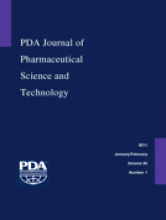Research ArticleResearch
In Situ Phase-Transited Asymmetric Membrane Capsules: A Means for Achieving Delayed and Osmotic Release for pH Solubility-Dependant Drugs
Anil K. Philip and Betty Philip
PDA Journal of Pharmaceutical Science and Technology January 2011, 65 (1) 32-41;

References
- 1.↵
- Santus G.,
- Baker R. W.
- 2.↵
- Theeuwes F.
- 3.↵
- Theeuwes F.,
- Saunders R. J.,
- Mefford W. S.
- 4.↵
- Herbig S. M.,
- Cardinal J. R.,
- Korsmeyer R. W.,
- Smith K. L.
- 5.↵
- Philip A. K.,
- Pathak K.
- 6.↵
- Philip A.,
- Pathak K.
- 7.↵
- 8.↵
- 9.↵
- Gupta S. K.,
- Atkinson L.,
- Theeuwes F.,
- Wong P.,
- Longstreth J.
- 10.↵
- 11.↵
- La Rosa F.,
- Ripa S.,
- Prenna M.,
- Ghezzi A.,
- Pfeffer M.
- 12.↵
- Buck R. E.,
- Price K. E.
- 13.↵
- Schnurch A. B.,
- Guggi D.,
- Pinter Y.
- 14.↵
- Bhagwati S. T.,
- Hiremath S. M.,
- Sreeniwas S. A.
- 15.↵
- Sweetman S. C.
- 16.↵
- 17.↵
- Zentner G. M.,
- McClelland G. A.,
- Sutton S. C.
- 18.↵
- Martin A.
- 19.↵
United States Pharmacopoeia, 4th ed; United State Pharmacopoeial Convention: Rockville, MD, 2004; p 2308.
- 20.↵
- Najib N.,
- Suleiman M.
- 21.↵
- Desai S. J.,
- Singh P.,
- Simonelli A. P.,
- Higuchi W. I.
- 22.↵
- Higuchi T.
- 23.↵
- 24.↵
- Korsmeyer R. W.,
- Gurny R.,
- Doelker E. M.,
- Buri P.,
- Peppas N. A.
- 25.↵
- 26.↵
- Kamba M.,
- Seta Y.,
- Kusai A.,
- Nishimura K.
- 27.↵
- Kamba M.,
- Seta Y.,
- Kusai A.,
- Ikeda M.,
- Nishimura K.
- 28.↵
In This Issue
PDA Journal of Pharmaceutical Science and Technology
Vol. 65, Issue 1
January/February 2011
In Situ Phase-Transited Asymmetric Membrane Capsules: A Means for Achieving Delayed and Osmotic Release for pH Solubility-Dependant Drugs
Anil K. Philip, Betty Philip
PDA Journal of Pharmaceutical Science and Technology Jan 2011, 65 (1) 32-41;
Jump to section
Related Articles
- No related articles found.
Cited By...
- No citing articles found.





